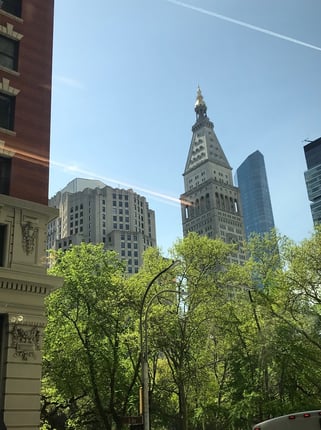On a recent trip to New York, I learned the story about the MetLife North Building. Originally proposed as a 100-story-tower, MetLife sought to build the tallest skyscraper in the world in the 1920s. Then the Great Depression hit.
 Construction halted and they put the dream on hold. That happened a lot in New York in the 1930s.
Construction halted and they put the dream on hold. That happened a lot in New York in the 1930s.
They had to regroup and change plans to make the building functional. Today, only the 32-story base remains with the foundational strength and elevator shafts (100 of them) needed for a building three times its size. (Here's a picture my wife took of the building today).
It reminded me of the many times that we have to stop, reassess and make new plans as organizations. There was a time when Marco had a strategy to be a retail office products superstore, and we developed plans to achieve it. Then the Recession hit in 1991 which caused us to take a different path.
As leaders and strategists, it’s our responsibility to navigate unexpected barriers that have the potential to wipe out even our best plans. We need to identify alternate routes to position our organizations to be resilient and sustainable long-term.
We’ve participated in three recessions during my 35 years here at Marco. We have also transitioned our company from office products and typewriters to the technology services company we are today.
When faced with barriers, we ask ourselves the following questions to help navigate the situation:
- What is the worst-case scenario?
One of the hardest things to do is give up on Plan A, but there are always options. Sometimes a good Plan B can be even better than the original plan. In the case of the MetLife building, it was a shorter, stronger and still highly functional building.
- What is a more realistic scenario?
MetLife leaders and their designers modified their original plans and chose to build only a portion of the proposed tower. What was functional for decades is still in use today. In the case of our office products plan, we could have continued to operate our retail storefront knowing we were going to struggle to achieve our intended goals. Instead, we changed course and developed a strategy to build a more sustainable technology services business.
Navigating barriers – in the economy, in our industry and in the life of a business – is a natural part of leadership. The pace of change is far more substantial today than ever before, and we find ourselves constantly considering the barriers. We’ve learned that the higher the barrier of entry, the higher the reward.
We all have future disruptors that could completely change how we do business. As leaders, how we navigate these will determine the sustainability of our business long-term. The execution plans may be more complicated, but the rewards will be far greater for those who are willing to navigate them.
What are the barriers in your business today? How prepared are you for the unforeseen barriers of the future?
